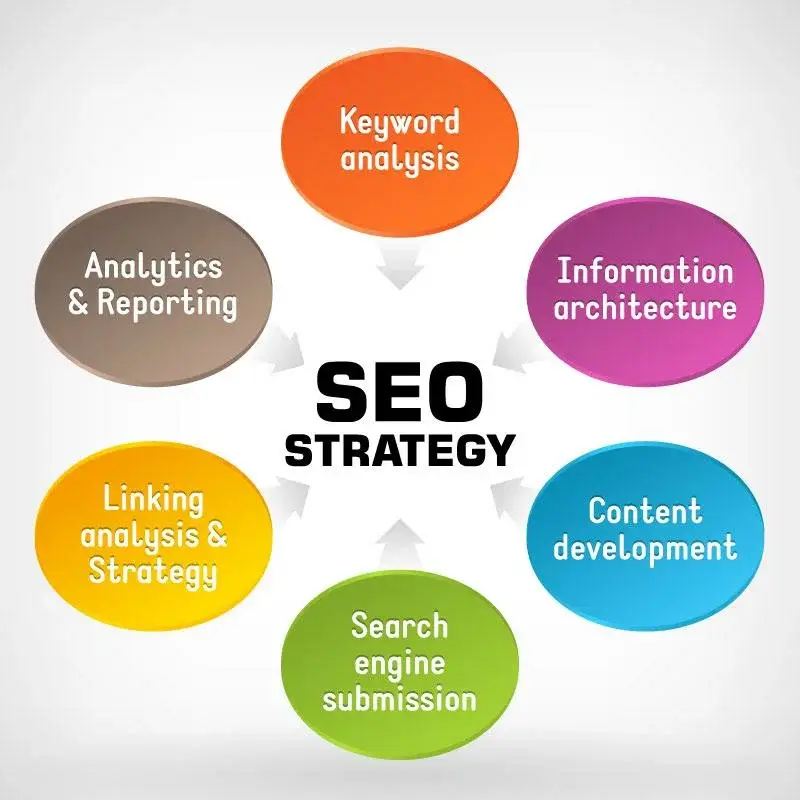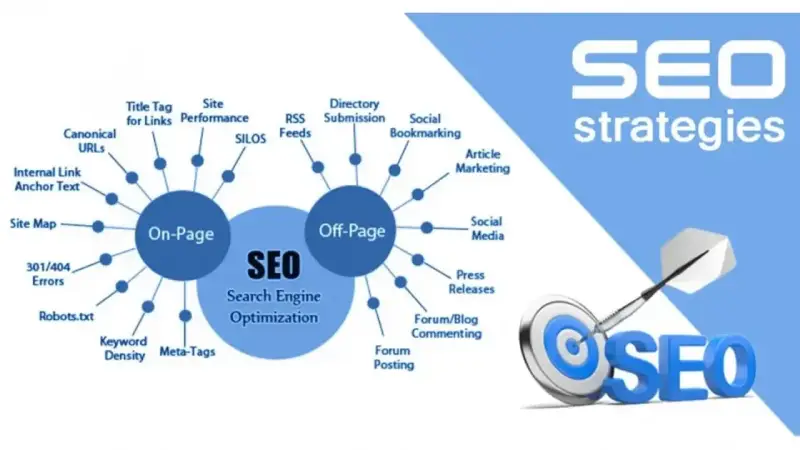As we navigate the evolving digital landscape of 2025, search engine optimization (SEO) remains a cornerstone of online visibility and success. The rapid advancements in technology and shifting user behaviors necessitate a keen understanding of emerging trends and strategic adaptations. Herein, we explore the pivotal SEO strategies that will define success in 2025, expanding on each point to provide a comprehensive guide for SEO professionals and digital marketers.

Embracing Artificial Intelligence in SEO
Artificial Intelligence (AI) has transcended its nascent stages to become integral in shaping SEO strategies. Modern search engines leverage AI to better understand user intent and deliver more relevant search results. Consequently, SEO professionals must harness AI tools to optimize content effectively.
Key Actions:
Utilize AI-Powered SEO Tools:
AI-powered SEO tools have become indispensable for modern marketers. These tools can analyze vast datasets to uncover insights into keyword trends, user behavior, and content performance. For instance, tools like Surfer SEO, Clearscope, and MarketMuse use AI to provide recommendations for optimizing content based on top-performing pages. By leveraging these tools, marketers can identify gaps in their content, discover high-performing keywords, and understand the competitive landscape. AI tools also help in automating repetitive tasks such as keyword research, backlink analysis, and performance tracking, allowing SEO professionals to focus on strategic decision-making.
Predictive Analysis:
AI’s predictive capabilities are revolutionizing how marketers approach SEO. By analyzing historical data and current trends, AI can forecast future search behaviors and emerging topics. This allows businesses to create content proactively, staying ahead of the curve. For example, AI can predict seasonal trends, enabling e-commerce businesses to optimize their product pages before peak shopping periods. Predictive analysis also helps in identifying potential shifts in user intent, allowing marketers to adjust their strategies accordingly. By aligning content with anticipated trends, businesses can capture traffic early and establish themselves as thought leaders in their niche.
Content Optimization:
AI is transforming how content is optimized for search engines. Natural Language Processing (NLP) algorithms enable AI tools to understand the context and semantics of content, ensuring it aligns with user queries and search engine algorithms. AI can suggest improvements to content structure, readability, and keyword placement, making it more likely to rank higher in search results. Additionally, AI-driven tools can analyze competitor content to identify opportunities for differentiation. For example, tools like Frase and Writesonic use AI to generate content outlines, meta descriptions, and even full articles that are optimized for SEO. However, it’s crucial to balance AI-generated content with human creativity to maintain authenticity and engagement.
Optimizing for Voice Search
The proliferation of voice-activated devices has revolutionized how users conduct searches. Voice search queries tend to be more conversational and longer than text-based searches, necessitating a shift in SEO tactics.
Key Actions:
Incorporate Natural Language Keywords:
Voice search queries are often phrased as questions or statements, such as “What’s the best Italian restaurant near me?” or “How do I fix a leaky faucet?” To optimize for voice search, marketers must focus on long-tail keywords that mimic natural speech patterns. This involves understanding the specific phrases and questions users are likely to ask and incorporating them into content. Tools like AnswerThePublic and SEMrush can help identify common voice search queries related to your industry. Additionally, optimizing for featured snippets is crucial, as voice assistants often pull answers from these highlighted search results.
Develop FAQ Sections:
Creating FAQ sections on your website is an effective way to cater to voice search queries. By addressing common questions directly within your content, you increase the likelihood of being featured in voice search results. For example, a plumbing service website could include FAQs like “How do I unclog a drain?” or “What causes low water pressure?” These sections should be concise, informative, and structured in a way that search engines can easily parse. Using schema markup for FAQs can further enhance visibility in search results.
Enhance Local SEO Efforts:
Voice searches often have local intent, such as “Where’s the nearest coffee shop?” or “Find a dentist near me.” To capitalize on this trend, businesses must ensure their local SEO efforts are robust. This includes optimizing Google My Business profiles, ensuring NAP (Name, Address, Phone Number) consistency across directories, and collecting positive reviews. Localized content, such as blog posts about community events or neighborhood guides, can also boost visibility in local search results. Additionally, using location-based keywords in meta descriptions and content can help attract voice search traffic.
Prioritizing Expertise, Authoritativeness, and Trustworthiness (E-A-T)
Google’s emphasis on E-A-T principles underscores the importance of producing credible and reliable content. Establishing your site’s authority and trustworthiness is crucial for higher search rankings.
Key Actions:
Showcase Author Credentials:
Highlighting the expertise of content creators is essential for building trust with both users and search engines. This can be achieved through detailed author bios that include credentials, experience, and links to professional profiles. For example, a medical website should feature articles written by licensed doctors, with bios that highlight their qualifications. Including author photos and links to their social media profiles can further enhance credibility. Additionally, guest posts from industry experts can bolster your site’s authority.
Secure High-Quality Backlinks:
Backlinks from reputable websites are a key factor in establishing authority. Focus on earning links from trusted sources such as industry publications, educational institutions, and government websites. Outreach strategies, such as guest blogging, collaborating on research studies, or creating shareable infographics, can help attract high-quality backlinks. It’s also important to monitor your backlink profile and disavow toxic links that could harm your site’s reputation.
Maintain Content Accuracy:
Regularly updating content to ensure it reflects the most current and accurate information is crucial for maintaining trustworthiness. This is especially important for industries where information changes rapidly, such as technology, healthcare, and finance. Implementing a content audit schedule can help identify outdated information and ensure all content remains relevant. Additionally, citing authoritative sources and providing references can enhance the credibility of your content.
Enhancing Mobile-First User Experience
With Google’s mobile-first indexing, the mobile version of your website is the primary determinant of your search rankings. A seamless mobile experience is imperative.
Key Actions:
Implement Responsive Design:
A responsive design ensures your website adapts flawlessly across various devices and screen sizes. This not only improves user experience but also boosts SEO performance. Tools like Google’s Mobile-Friendly Test can help identify issues with your site’s mobile responsiveness. Additionally, using flexible grids, scalable images, and CSS media queries can enhance the adaptability of your design.
Optimize Page Load Speed:
Mobile users expect fast-loading pages, and slow load times can lead to higher bounce rates. Optimizing images, leveraging browser caching, and utilizing content delivery networks (CDNs) are effective strategies for improving page speed. Tools like Google PageSpeed Insights can provide recommendations for enhancing performance. Minimizing JavaScript and CSS files, and using asynchronous loading for scripts can also reduce load times.
Simplify Navigation:
Designing intuitive mobile navigation is essential for enhancing user engagement. This includes using a hamburger menu, clear call-to-action buttons, and a logical hierarchy of pages. Ensuring that links and buttons are easily clickable on smaller screens can improve usability. Additionally, implementing breadcrumb navigation can help users understand their location within your site and navigate more efficiently.
Adapting to Zero-Click Searches
Zero-click searches, where users obtain answers directly from the search results without clicking through to a website, are increasingly common. Adapting to this trend is essential for maintaining visibility.
Key Actions:
Optimize for Featured Snippets:
Structuring content to answer common questions concisely increases the likelihood of being featured directly in search results. Using headers, bullet points, and numbered lists can help search engines identify and extract relevant information. Tools like SEMrush and Ahrefs can help identify opportunities for featured snippets.
Utilize Structured Data Markup:
Implementing schema markup helps search engines understand your content and present it effectively in rich snippets. This includes markup for FAQs, recipes, reviews, and events. Using tools like Google’s Structured Data Testing Tool can ensure your markup is correctly implemented.
Focus on Local SEO:
Ensuring your business information is accurate and readily available can capture local search queries that often result in zero-click outcomes. Optimizing Google My Business profiles and using local keywords in content can enhance visibility.
Leveraging Video Content for SEO
Video content continues to surge in popularity, offering unique opportunities for SEO enhancement. Search engines increasingly prioritize video results, making video optimization a critical component of your strategy.
Key Actions:
Optimize Video Metadata:
Incorporating relevant keywords into video titles, descriptions, and tags improves discoverability. Using tools like TubeBuddy and VidIQ can help optimize YouTube videos for search.
Provide Transcripts:
Offering transcripts of video content enhances accessibility and provides additional text for search engines to index. This can also improve the chances of appearing in voice search results.
Encourage Engagement:
Fostering user interaction through likes, shares, and comments signals content value to search engines. Creating engaging thumbnails and compelling titles can boost click-through rates.
Focusing on Core Web Vitals and User Experience
Google’s Core Web Vitals emphasize the importance of user experience metrics, such as loading speed, interactivity, and visual stability. Prioritizing these elements is crucial for SEO success.
Key Actions:
Improve Loading Times:
Optimizing resources to ensure swift page loads enhances user satisfaction. Techniques include image compression, lazy loading, and minimizing HTTP requests.
Enhance Visual Stability:
Preventing layout shifts during loading provides a stable viewing experience. This can be achieved by specifying image dimensions and avoiding dynamic content injections.
Boost Interactivity:
Ensuring interactive elements respond promptly to user inputs reduces frustration and improves engagement. Optimizing JavaScript execution and using efficient event handlers can enhance interactivity.
Integrating AI-Generated Content Responsibly
The rise of AI-generated content offers both opportunities and challenges. While AI can assist in content creation, maintaining authenticity and quality is paramount.
Key Actions:
Blend AI with Human Oversight:
Using AI tools to generate content ideas or drafts, but involving human editors ensures accuracy and authenticity. This hybrid approach combines efficiency with creativity.
Prioritize Originality:
Focusing on creating unique content that reflects your brand’s voice and values avoids generic AI outputs. Customizing AI-generated content to align with your brand identity is essential.
Maintain Transparency:
Disclosing the use of AI in content creation builds trust with your audience. Being upfront about AI’s role in your content strategy fosters transparency.

Embracing Multimodal Search Capabilities
Search engines are evolving to interpret various content types, including text, images, and videos. Optimizing for multimodal search enhances your content’s reach and visibility.
Key Actions:
Optimize Visual Content:
Using descriptive filenames and alt text for images improves searchability. Tools like Canva and Adobe Spark can help create visually appealing content.
Incorporate Rich Media:
Enhancing content with infographics, interactive elements, and videos caters to diverse user preferences. This multimodal approach increases engagement and shareability.
Implement Structured Data:
Using schema markup helps search engines understand and index different content formats effectively. This includes markup for images, videos, and articles.
Prioritizing Sustainability and Ethical Practices
As consumers become more environmentally conscious, demonstrating sustainability and ethical practices can positively influence SEO performance.
Key Actions:
Adopt Green Hosting:
Using eco-friendly web hosting services reduces your website’s carbon footprint. Providers like GreenGeeks and SiteGround offer sustainable hosting options.
Promote Sustainable Practices:
Highlighting your brand’s commitment to sustainability through content and initiatives can attract environmentally conscious consumers. This includes showcasing eco-friendly products, recycling programs, and carbon offset initiatives.
Ensure Ethical SEO Practices:
Avoiding black-hat SEO techniques and focusing on ethical strategies builds long-term trust and credibility. This includes transparent link-building, honest content creation, and adherence to search engine guidelines.
By embracing these strategies, businesses can navigate the complexities of SEO in 2025 and achieve sustained online success. The integration of AI, optimization for emerging technologies, and a commitment to ethical practices will be key to staying ahead in the competitive digital landscape.

